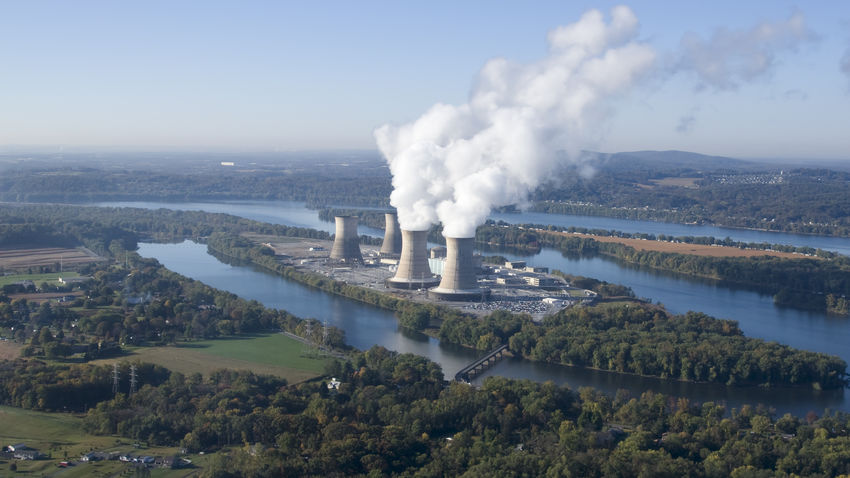
The partial meltdown of the Three Mile Island (TMI) nuclear reactor in March 1979 near Harrisburg, Pa., was the worst nuclear accident in U.S. history, exposing around two million people to radioactive fallout. A combination of equipment malfunctions and operator errors led to the accident. Workers in the control room as well as plant and government officials were caught off guard by the unprecedented event and forced to make quick decisions.
At the time of the accident there were no township evacuation plans, and Pennsylvania’s emergency plan had not been approved by the U.S. Nuclear Regulatory Commission (NRC). Two days after the event, Pennsylvania Governor Richard Thornburg advised pregnant women and preschool children within a 5-mile radius of the nuclear plant to evacuate, resulting in approximately 144,000 people leaving their homes. The accident prompted the NRC to tighten regulatory oversight and brought broad changes in emergency response planning, operator training and other areas of nuclear power plant operations.
Now, a recently published five-year study by investigators at Temple, Penn State, and University of Pittsburgh explores decades of public health studies conducted in the accident's wake, as well unpublished reports and transcripts from the expert advisory panel assembled by the Pennsylvania Secretary of Health after the accident. In guidance aimed primarily at the epidemiology community, the paper highlights shortcomings in information gathering and analysis that have obscured a clear picture of the accident’s health impact. While public health response to the TMI accident got off to a promising start with a large commitment and the best intentions, just like the engineers and technicians in the power plant, researchers' immediate and long-term response was imperfect.
"The main message of the article is that we want to bring this information to the forefront, especially for governments and researchers, so that we can have plans in place and we do not repeat the mistakes of the past," says Temple's Robin Taylor Wilson, associate professor in the Department of Epidemiology and Biostatistics. "We need to establish mechanisms to ensure long‐term follow‐up, and we need pre-accident protocols designed to address major health issues with inclusion of vulnerable populations and perceived risks. We can’t wait for accidents to occur."
Their paper, published in November in Risk, Hazards & Crisis in Public Policy, is titled “What have we learned about health effects more than 40 years after the Three Mile Island nuclear accident? A scoping and process review.” Wilson led the study, and the University of Pittsburgh's Evelyn Talbott, principal investigator of the largest and longest cancer outcomes follow-up of the TMI population, served as the team’s senior author.
Most studies examining potential cancer effects of accident radiation on residents did not gather data about potential confounding factors such as whether residents smoked or about their normal workplace exposure to radiation. Most studies also failed to use a TMI-unexposed control group for comparison and instead relied upon comparisons of the exposed population within a relatively small geographic area (5-miles or 10-miles).
Despite multiple public statements by the Pennsylvania Department of Health that careful evaluation of immediate and long-term follow-up of children should be conducted, the longest follow-up for childhood cancer was limited to the years 1985 to 1995 and did not include children outside of the 5-mile radius. Similar problems with discontinuity of health research follow‐up were observed in the wake of the Chernobyl and Fukushima nuclear accidents, the paper says. The team compared meeting transcripts to the record of published and unpublished research and found that only a small portion of the planned analyses were ever conducted.
"The nuclear energy industry has used TMI as a case study in training nuclear engineers, but there are lessons for public health researchers as well, " says Wilson. The paper suggests ways that follow-up of future incidents might be more effective, including more community engagement in the research and built-in mechanisms to ensure long-term follow-up will continue—especially for outcomes like cancer which may take decades to develop."
Public health research following TMI did begin well. Wilson's research project gained access to unpublished studies and meeting transcripts from the Pennsylvania Department of Health’s TMI Advisory Panel on Health Research Studies. The panel was chaired by Leroy E. Burney, a former U.S. Surgeon General who, in 1957, had been the first federal official to publicly link smoking to lung cancer (and who, incidentally, later became Vice President for Health Sciences at Temple).
“All these internationally renowned experts came together, and there was really careful consideration about what should be done,” Wilson says.
In the immediate aftermath of the accident, the TMI Census of over 35,000 residents within the five-mile radius had been conducted in June 1979. “The work involved was tremendous. They were under intense pressure to get in the field, knocking on people’s doors to ask the right questions. But it was just a brief three-page questionnaire,” Wilson explains. This meant that the panel of experts began meeting after the TMI Census was conducted, and not all of the information they wanted to be collected was included.
Additional clinical follow-up of medical records among pregnant women giving birth within a 10-mile radius of TMI also was underway, known as the Pregnancy Outcomes Study (POS). The POS collected detailed information, though only one of their six investigations was published in peer-reviewed literature. In contrast to most other studies, the POS collected detailed information on several potential confounding factors, but similar to limitations of cancer studies, POS studies did not include TMI accident-unexposed control groups.
Wilson believes that understanding the successes and flaws of past research on cancer effects can help guide her current epidemiological studies of cancer links with polyfluoroalkyl substances (PFAS), hazardous chemicals contaminating water in communities north of Philadelphia.
"From what I and my colleagues have observed, we are still in a reactionary state—both for nuclear incidents as well as other slow-moving technological disasters, like PFAS. What we want to do is learn from the past and orient ourselves moving forward,” she says.
